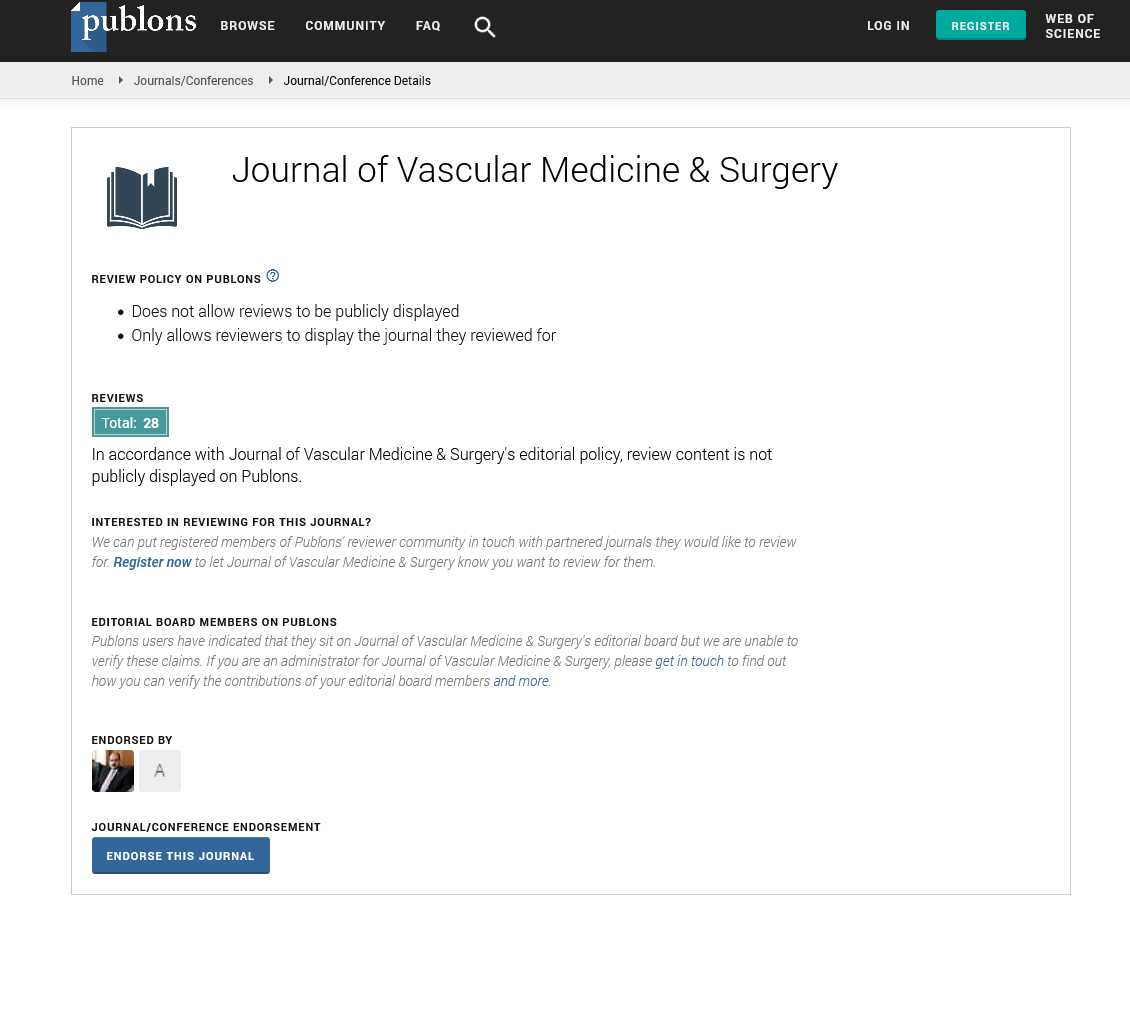Indexed In
- Open J Gate
- Academic Keys
- RefSeek
- Hamdard University
- EBSCO A-Z
- OCLC- WorldCat
- Publons
- Euro Pub
- Google Scholar
- SHERPA ROMEO
Useful Links
Share This Page
Journal Flyer

Open Access Journals
- Agri and Aquaculture
- Biochemistry
- Bioinformatics & Systems Biology
- Business & Management
- Chemistry
- Clinical Sciences
- Engineering
- Food & Nutrition
- General Science
- Genetics & Molecular Biology
- Immunology & Microbiology
- Medical Sciences
- Neuroscience & Psychology
- Nursing & Health Care
- Pharmaceutical Sciences
Commentary - (2024) Volume 12, Issue 6
Development of Modern Treatment Methods for Hemorrhage Control and Bleeding Disorders
Denis Alian*Received: 25-Oct-2024, Manuscript No. JVMS-24-27809; Editor assigned: 29-Oct-2024, Pre QC No. JVMS-24-27809 (PQ); Reviewed: 12-Nov-2024, QC No. JVMS-24-27809; Revised: 19-Nov-2024, Manuscript No. JVMS-24-27809 (R); Published: 26-Nov-2024, DOI: 10.35248/2329-6925.24.12.572
Description
The loss of blood from the vascular system is known as hemorrhage, and it is a common medical emergency that needs to be treated quickly and effectively. Worldwide, hemorrhage continues to be a major cause of morbidity and death, especially in surgical and traumatizing environments. Medical research has been advanced, but prompt diagnosis and efficient treatment are still major obstacles. New technologies that have the potential to revolutionize hemorrhage therapy and enhance patient outcomes include artificial intelligence, resuscitation techniques, and hemostatic drugs. Trauma, surgical complications, gastrointestinal disorders, or obstetric problems can all cause it. The World Health Organization states that, one of the main preventable causes of death in worldwide is uncontrolled bleeding. The circulatory system of the human body has been damaged by hemorrhage, which results in insufficient oxygen supply and blood circulation to the tissues. It goes through four stages based on severity, such as Class I, which has minimal blood loss (<15%) and no notable clinical symptoms. Class II patients experience tachycardia, a decrease in pulse pressure, and anxiety due to moderate blood loss (15%-30%). Class III patients experience hypotension, oliguria, and impaired mental status due to substantial blood loss (30%-40%). Class IV blood loss is life-threatening (>40%) and can lead to severe hypotension, organ failure, and even death.
Vasoconstriction, coagulation cascade activation, and blood reserve mobilization are all part of the body's reaction to bleeding. However, coagulopathy, hypovolemic shock, and multiorgan failure can result from heavy or protracted bleeding. Combat Application Tourniquets (CATs), is a type of modern tourniquet, is very good at stopping bleeding in the extremities. Hemostatic cloths that are treated with chitosan or kaolin increase the formation of clots. Early hemorrhage control, balanced blood product transfusion, and minimizing crystalloid fluids are the main objectives of damage control resuscitation, or Dacryocystorhinostomy (DCR). Acceptable Hypotension Systolic blood pressure should be kept between 80 mmHg and 90 mmHg to prevent clots from moving while maintaining sufficient perfusion. Reducing coagulopathy and increasing survival rates is done by administering blood components in a predetermined ratio, such as 1:1:1 for red blood cells, plasma, and platelets. Someone may have a bleeding condition, which is when the blood does not clot normally. This occurs when the body either produces insufficient platelets or clotting factors, or they do not function as intended. In most cases, a blood clot forms to immediately stop bleeding when somebody is harmed. The clot then melts on its own.
A person's blood needs a type of blood cell called platelets and blood proteins called clotting factors in order to form a clot. Some people have clotting issues because of genetic diseases or other medical conditions. Nearly 75 million years of life are lost annually due to hemorrhage, which is thought to be the cause of over 60,000 fatalities in the US and 1.5 million deaths globally. A brain bleed can be treated surgically to stop the bleeding and deal with the underlying cause. Ten units of oxytocin administered intramuscularly as soon as possible after delivery, together with active management of the third stage, is the primary prophylactic therapy for postpartum hemorrhage. The majority of sub-conjunctival hemorrhage cases resolve on their own without medical intervention. A person can typically bleed to death in a matter of minutes if the bleeding is not stopped. External traumatic bleeding can be treated. In many cases, local first aid is adequate for minor wounds. Serious wounds are considered medical emergencies, and more involved treatments including stitches, medication-assisted dressings, and surgery may frequently be necessary.
When blood leaks out of injured blood arteries, the hemorrhages happen. Because blood is delivered to every part of the body by the circulatory system, they can occur practically anywhere. Hemorrhagic shock, a medical emergency that can quickly become lethal, is the most severe type of bleeding. When the body loses so much blood that the heart cannot keep up, important organs start to fail, a condition known as hemorrhagic shock. External hemorrhage is typically fairly easy to detect, and the bleeding cause can be found rapidly. Even for medical professionals, diagnosing internal hemorrhage can be challenging. Machine learning algorithms are being developed to use patient data to guide treatment decisions and anticipate the severity of hemorrhages. Though improvements in technology, pharmacology, and surgical methods have significantly improved results, hemorrhage still presents substantial challenges in clinical practice. To keep reducing the burden of hemorrhagerelated morbidity and mortality worldwide, ongoing research and innovation are essential. With the integration of advanced instruments and individualized care strategies, hemorrhage control appears to have a bright future.
Citation: Alian D (2024). Development of Modern Treatment Methods for Hemorrhage Control and Bleeding Disorders. J Vasc Surg. 12:572
Copyright: © 2024 Alian D. This is an open-access article distributed under the terms of the Creative Commons Attribution License, which permits unrestricted use, distribution, and reproduction in any medium, provided the original author and source are credited.

